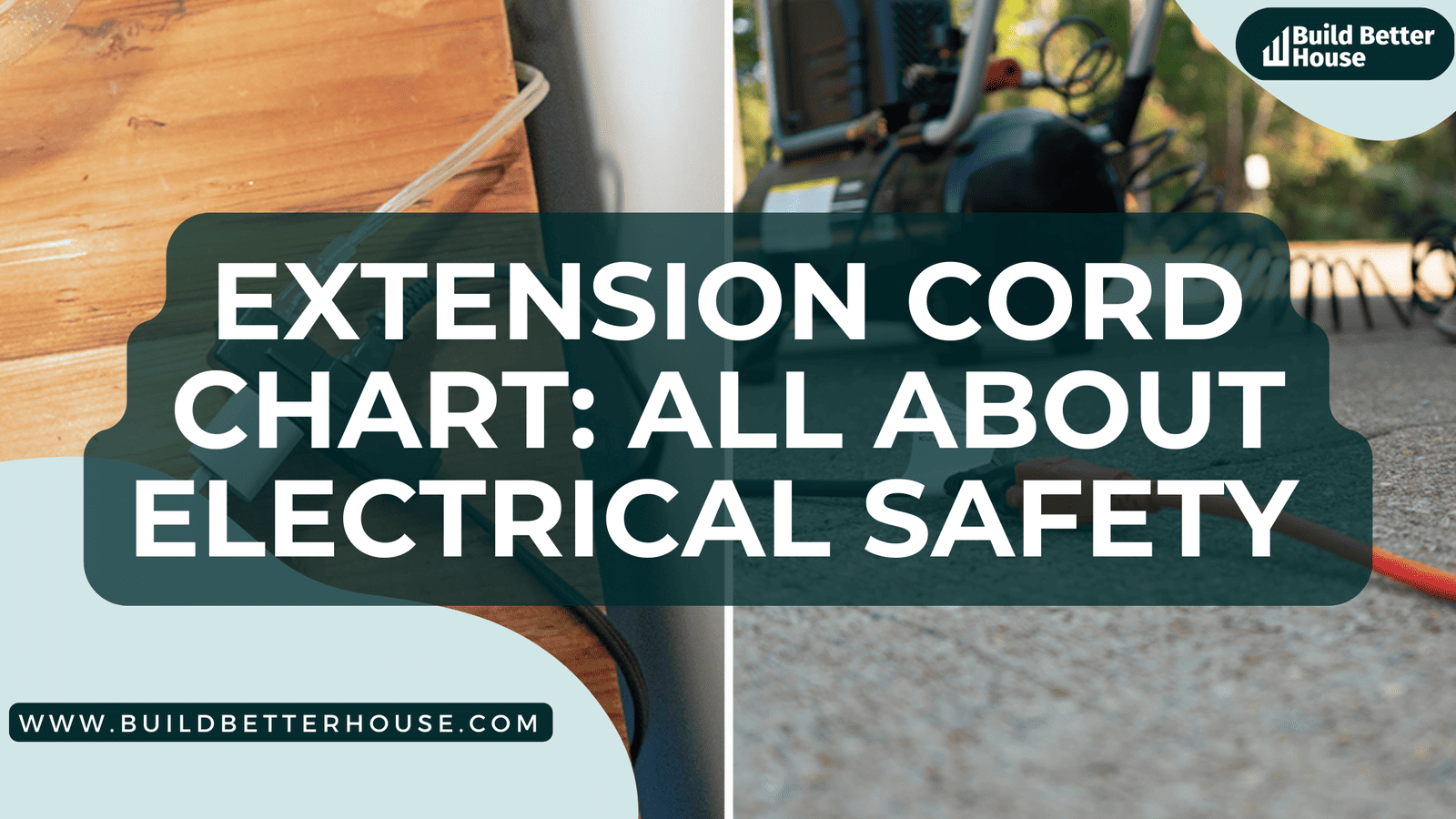Extension Cord Chart: What You Must Know On Safety

Ever wonder how to use an extension cord chart correctly and safely? Since an extension cord chart is one of the finest solutions to a scarcity of electrical outlets because so many devices require power outlets. Yet, if utilized improperly, they also pose a risk.
FAQs
1. How long should you use an extension cord chart?
Extension cables should only be used temporarily -up to 90 days in General Industry workplaces
2. Are extension cord charts waterproof?
All-purpose extension cables should never be used outside because they are quickly shorted out and are not water-resistant. Ensure the connectors and plugs on an extension cord are waterproof before using it in a moist climate. A waterproof cap should also be placed over the cord’s plug.
3. How many extension cord charts can be connected?
No, you shouldn’t connect two extension cables at the same time. The resistance of the extension leads increases as two or more are connected. Fires and overheating may result from this.
4. Do multiple extension cord charts reduce power?
The resistance of the extension cable effectively rises after two identical extension leads are linked in series, one after the other. This causes the cord to heat up more and may harm the insulation, which can start fires and cause electric shocks.
Basics of extension cord chart
An extension cord chart is an essential tool when dealing with electrical wiring. It is an organized and tabulated chart outlining the extension cords types and their associated amperage, voltage, and wattage ratings. This chart serves as a useful reference guide when determining the compatibility of a particular extension cord with the electrical devices it will be connecting.
The extension cord chart allows one to quickly determine the type of extension cord and its amperage, voltage, and wattage ratings best suited for particular appliances and devices. This chart is also beneficial in deciding which type of extension cord is most suitable for a particular application.
For instance, if one connects a power tool or a device that consumes a lot of electricity, a higher amperage, voltage, and wattage rating is needed. On the other hand, if the connected device requires only a small amount of electricity, then a lower amperage, voltage, and wattage rating is adequate.
Types of extension cord charts
Extension cord charts can be incredibly useful for anyone who needs to select the right type of power cord for their specific needs. Whether setting up a workshop, powering a tech device, or just looking for a way to reach an outlet, an extension cord chart can help you find the right type of cord.
An extension cord chart lists the most common available extension cords, including their power ratings and the types of outlets they are typically used with.
- One type of extension cord chart will list the different types of cords based on the type of plug they use.
For example, an extension cord chart might list the 2-prong and 3-prong cords and the common outlets they are used with. This chart type is especially useful if you want an extension cord that fits into a specific outlet.
The chart can also provide helpful information about the power rating of the cord, so you can ensure it can provide the power your device needs.
- Another type of extension cord chart will list the cords based on their power ratings. This type of chart is great if you need to determine the power rating of a particular cord.
The chart will list the various amperage ratings of the cords and the types of outlets they are typically used with. This chart type is especially useful for those setting up a workshop or powering a tech device.
- Finally, some extension cord charts also list the various lengths of cords available. This chart type can be very helpful if you need to select the right cord length for a particular job.
It can also be helpful if you need to determine the total length of extension cords you need for a particular project.
With an extension cord chart, you can make sure you’re selecting the right type of cord for your specific needs.
American Wire Gauge (AWG)
American Wire Gauge (AWG) determines the appropriate extension cord for any job. AWG is a standardized wire gauge system used to determine the diameter of electrical wires and cables.
It measures a wire’s current-carrying capacity, with higher AWG numbers representing thinner wires that can carry less current and lower AWG numbers representing thicker wires capable of carrying more current.
When selecting an extension cord chart, it is important to consider your equipment’s or devices’ power requirements and match them up with the correct AWG rating.
Extension cord charts provide information on what type of extension cord should be used depending on the current capacity needed by devices or appliances connected to it. Taking into account both the type of extension cord and its corresponding AWG rating can ensure a safe and successful electrical project.
Indoor vs. outdoor cords
Regarding electrical projects, it is essential to consider the differences between indoor and outdoor extension cord charts. The main difference lies in their insulation; indoor cords are typically made with thinner insulation than outdoor ones and are not meant to be used outdoors due to the increased risk of electric shock or fire.
Furthermore, outdoor extension cord charts should have a higher AWG rating than their indoor counterparts to handle better voltage drops when an electrical current passes through them.
When selecting an extension cord chart for a project, check its intended purpose and choose one designed for indoor or outdoor use. Taking the time to ensure you are using the correct type of cord can go a long way toward helping avoid potential disasters related to voltage drops and electric shocks.
Choosing the right extension cord
When selecting an extension cord, it is important to consider whether it is intended for indoor or outdoor use, as the two have major differences.
Indoor cords typically have thinner insulation than outdoor ones and should never be used outdoors due to the increased risk of electric shock or fire.
Outdoor extension cords must have a higher AWG rating than their indoor counterparts to handle better voltage drops when an electrical current passes through them.
Taking the time to choose the right type of cord can help prevent dangerous situations related to voltage drops and electric shocks. Be sure to select a cord designed specifically for its intended purpose to ensure maximum performance and safety.
Choosing the right extension cord for your project can make a difference in safety, performance, and efficiency. To ensure you’re getting the most out of your cord, select one designed specifically for its intended purpose.
Calculating amperage ratings
Knowing the amperage rating of an extension cord chart allows you to choose a product that will safely handle the power flow of your project without any risk of overloading or damaging the cord.
To calculate the amperage rating, multiply the voltage by the wattage and divide it by the total length of wire used for your project.
For example, if you use a 12-gauge cord with 120 volts and 1,000 watts at 10 feet long, you would use this formula: (120 x 1000) / 10 12 amps. This means a 12-gauge cord would be suitable for this application as it can handle up to 15 amps.
Always check manufacturers’ specifications before purchasing to ensure your chosen extension cord is suited for your specific project needs.
Maximum amperage ratings
When selecting an extension cord, it is important to understand the amperage rating of the product to ensure optimal safety and performance.
To calculate the amperage rating, multiply the voltage by the wattage and divide it by the total length of wire used for your project. Check manufacturers’ specifications before purchasing certain cords that may not suit your project needs.
Generally, choosing an extension cord chart with a maximum amperage rating of at least 15 amps or higher is advised. This will ensure you have plenty of power running through your extension cord chart without risking overload or damage.
With this information in mind, you can confidently choose an extension cord chart that suits your project needs and keeps you safe while in use.
Calculating voltage drop
Voltage drop is a term used to describe the decrease in voltage from the source of power to its end destination. Calculating the voltage drop for an extension cord is important as it helps determine if the cord can safely handle the electrical load without risking overload or damage.
To calculate the voltage drop:
- Simply divide the total length of the wire by the resistance per foot,
- Then multiply by the amperage rating of your project
- You may also need to adjust this calculation slightly depending on whether you use a single-conductor or multi-conductor extension cord and any other factors specific to your project.
These steps will help ensure that your extension cord chart provides enough power while keeping you safe during use.
Considerations for different pieces of equipment
When selecting an extension cord chart for an electrical project, it’s important to consider the voltage drop associated with the length of the wire. The longer the wire is, the greater the voltage drop will be; thus, more power will be lost over time.
It’s also important to consider what equipment you plan to use with your extension cord chart. Different types of equipment require different voltages and amperage ratings to function properly.
For example, a refrigerator typically draws more power than a lightbulb. Thus, it requires a higher voltage cord to ensure it can handle the load without overloading or being damaged.
In addition, multi-conductor extension cord charts are better suited for heavier-duty applications, while single-conductor cords are good for lighter loads.
Considering these factors when selecting an extension cord chart can help ensure your project runs smoothly and safely.
Similar tutorials
If you’re looking for a proper plumbing fixture calculator but aren’t sure if it’s worth it, check out this guide, where we’ve provided you with all the necessary information about plumbing fixture calculators.
Make your life easier with a french drain calculator. In this blog post, we’ll show you how to measure your french drain using a french drain calculator correctly, so keep reading for more information.
Since water damage is risky, the Govee water sensor review will help you protect your place better. This blog post of the Govee water sensor review will go over every vital aspect of this fantastic device, so check it out immediately.
Wrapping up
When selecting an extension cord for a project, it’s important to consider the voltage drop associated with the length of the wire. The longer the wire is, the more power will be lost over time.
Additionally, different types of equipment require specific voltages and amperage ratings to function properly. Considering these factors when selecting an extension cord can help ensure your project runs safely and efficiently. We hope this post has been helpful to you.
Read more:
Backflow Preventer For Sprinkler Systems: What You Must Know 2023
Raising Basement Ceiling Height: What You Need to Know 2023
How To Properly Extend The Sump Pump Discharge Pipe?
5 Best Ways To Reduce Humidity & Mold On The Basement Wall






